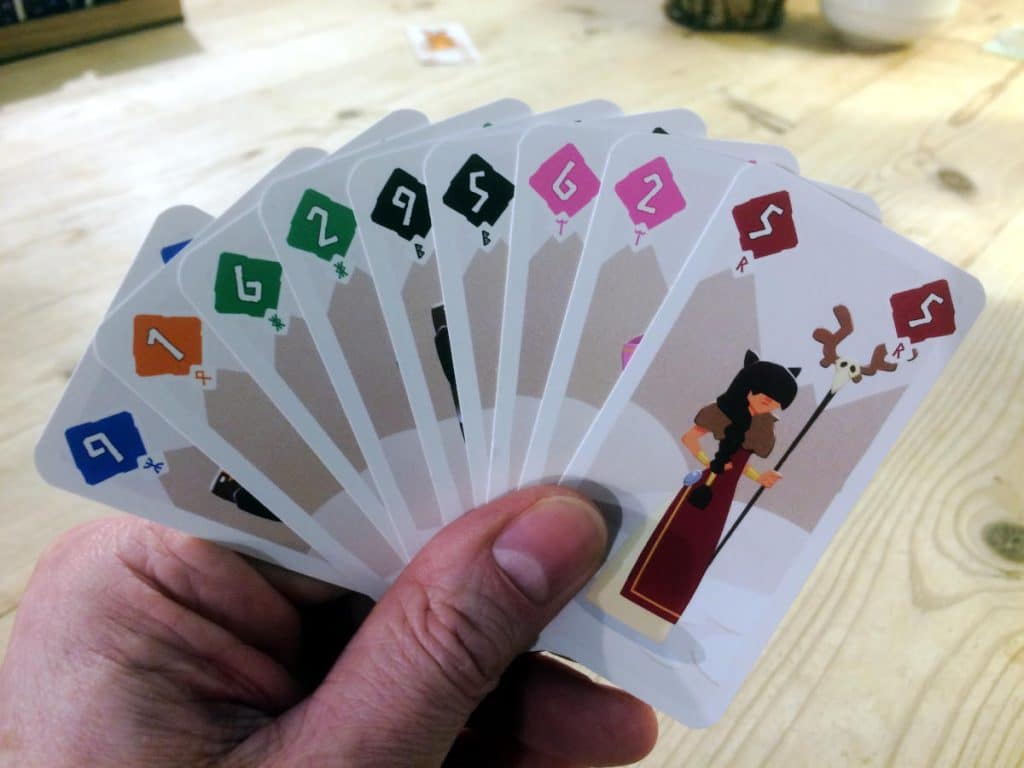I am a big fan of card games. Having grown up in Germany, a deck of cards was usually not far away. Playing trick-taking games was part of my youth, whether with the family or friends. I love card games in general and my love was rekindled when I was introduced to the modern hobby with games such as Citadels or Love Letter. I also found many new trick-taking games, but a genre that was new to me was so-called ladder-climbing games. In this article, I want to look at these fascinating games in more detail.
Listen to the Audio Version
Intro Music: Bomber (Sting) by Riot (https://www.
Leisure by Sascha Ende
Free download: https://filmmusic.
License (CC BY 4.0): https://filmmusic.
A Ladder-Climbing Introduction
Ladder-climbing games are all about being the first player to have no cards in your hand, which makes them also part of the genre of shedding games – but that’s not what I want to talk about here. What makes a ladder-climbing game a ladder-climbing game is that every player has to put down cards that are of a higher value in some shape or form.
Often these games are about playing sets or sequences of cards, such as three green cards or cards numbered two, three and four. A higher-value set or sequence is usually one that has more cards in it or cards with higher numbers. Each game will have its own rules as to what defines “higher value”.
It feels like you’re constantly trying to outbid the other players. As the sets and sequences grow, it gets harder and harder to play something of higher value. Every time you manage to play a bigger set or longer sequence, you secretly hope you’ve won, which creates tension. So when someone else somehow manages to go even higher, the tension is released and that’s one of the reasons why these games are so exciting.
Ladder-climbing games are almost like games of Poker, except that you’re not playing for money – even though I’m sure you could. You know what cards you have and as more cards are played, you can gauge what others might have. There is never perfect information, but if you’re good at keeping track of key cards, you can do quite well. There is also a certain bluffing element in these games, when you pretend to have bad cards and then surprise everyone by emptying your hand in one fell swoop.
Ladder-Climbing Examples: Scout
The first ladder-climbing game I played was the wonderful Scout from Oink Games. It’s possibly one of the more involved games in the genre I have played. While in a lot of ladder-climbing games, you are allowed to sort your hand of cards however you like and combine cards as you want, in Scout you have a fixed hand of cards. You can’t select different cards to make better sets or sequences. The cards have to be next to each other in your hand for you to be able to play them.
When you play a set of cards, you always take one of the cards already played back into your hand. Cards also have two values on them. As you add a card to your hand, you can create new sets and sequences. For example, if you have a two, four and five in your hand, adding a three suddenly creates a sequence of five consecutive cards.

Get yourself a wooden Tabletop Games Blog dice tray.
Each tray is the perfect size to roll your dice, and with the soft mat, it’s really quiet, while the wooden frame makes it wonderfully sturdy.
Scout isn’t just about outbidding the previous player. It’s more about looking at what card from the ones they played will improve your hand and play accordingly. Seeing the potential of your hand and improving it over time is key. It’s also more about not going over the top and leaving yourself with two or three useless cards. Scout is a really clever game that has some very simple rules that create a lot of depth.
Mind you, I wouldn’t necessarily recommend you start with Scout, if you haven’t played any ladder-climbing games before. I feel there is another game that is probably a better introduction to the genre, as it has fewer rules, allowing you to get used to this genre before delving deeper.

Odin
That game is Odin. It keeps it quite simple.
On your turn, you either play the same number of cards that have previously been played or one more. So, on the very first turn, you play one card. The next player can then either also play a single card or they can play two – and so on.
The cards you play have to either all be the same colour or the same number. If you play cards with different numbers but the same colour, you sort them from high to low. So if you were playing the three cards six, four and eight, for example, you’d play them as eight, six and four, making it 864.
The next player can then either also play three cards or they can play four. Either way, they have to play cards that make a higher value than the one you just played. So they could play nine, nine, nine – 999 – so three cards with the same number. Or they could play nine, two, one – 921 – so three cards with different numbers, but of the same colour. After you play a higher value, you have to take one of the cards played and discard the others. A bit like in Scout, it allows you to improve your hand and make higher-value combinations.
There are a few more rules, but that’s basically all there is to it. It makes Odin a really good game to introduce people to ladder-climbing games. In fact, Odin is such a solid game that you will enjoy it for a long time to come. It comes in a small box, making it easy to have on you at all times. It also takes up very little space on the table, so you can play it pretty much anywhere.
Sakana Stack
The third ladder-climbing game I want to talk about is the wonderful Sakana Stack. It’s sort of like Odin and Scout combined. You play sets of cards of the same number, but different colours. You add the numbers together to give you a total value. So three fours give you a stack value of 12. The next player then also has to play a stack with a value of 12 or a higher value. So they could play four threes or also three fours to match the previous stack. They could even play two sixes. Alternatively, they could play three fives for a stack value of 15.
However, they can’t just play any card. The top card of the current stack limits what the next player can play. They have to either play a card with the same number or the same colour. So if the top card of the current stack is a yellow four, then the next player can play a four of any colour or a yellow card, plus, of course, other cards of the same value to match or outbid the current stack.
If someone can’t do that, the top card of the current stack gets returned to the player who played that stack, giving them one victory point. However, that means the stack value is now smaller, which makes it easier for the next player. The top card of the draw deck is also available to players to add to the cards they want to play, creating even more options.
It sounds confusing and takes a little while to get into, but it’s a lot of fun and is a unique twist on the ladder-climbing genre that I have come across. It’s certainly worth having a look at Sakana Stack.
How About You?
So that’s some examples of ladder-climbing games and a brief introduction to the genre. Now I want to know if you’ve ever played any games like that. If so, what is your favourite game? Or maybe you’ve tried the genre but just didn’t get on with it. As always, please share your thoughts and experiences in the comments below. I’d love to hear from you.
For behind-the-scenes updates, branded merchandise, and more, please support the blog.
Useful Links
- Citadels: https://www.
asmodee. co. uk/ products/ zmgzc01-citadels-revised-edition - Love Letter review: https://tabletopgamesblog.
com/ 2021/ 01/ 23/ love-letter-saturday-review/ - Scout review: https://tabletopgamesblog.
com/ 2022/ 07/ 02/ scout-saturday-review/ - Odin review: https://tabletopgamesblog.
com/ 2024/ 03/ 30/ odin-saturday-review/ - Sakana Stack review: https://tabletopgamesblog.
com/ 2024/ 09/ 14/ sakana-stack-saturday-review/
Audio Version
Intro Music: Bomber (Sting) by Riot (https://www.
Leisure by Sascha Ende
Free download: https://filmmusic.
License (CC BY 4.0): https://filmmusic.
Playlist
These are the songs I listened to while I was writing this topic discussion article:





